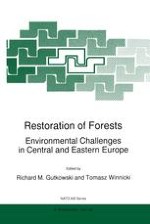1997 | OriginalPaper | Buchkapitel
Central European Hot Spots of Air Pollution
verfasst von : J. M. Pacyna, K. Tørseth
Erschienen in: Restoration of Forests
Verlag: Springer Netherlands
Enthalten in: Professional Book Archive
Aktivieren Sie unsere intelligente Suche, um passende Fachinhalte oder Patente zu finden.
Wählen Sie Textabschnitte aus um mit Künstlicher Intelligenz passenden Patente zu finden. powered by
Markieren Sie Textabschnitte, um KI-gestützt weitere passende Inhalte zu finden. powered by
At the beginning of the 1980’s major concern of the public was drawn on unusually high degradation of forests in Europe, particularly in most Central and Eastern European countries. Major symptoms observed were reduced foliar densities and foliar discoloration of tree crowns. For the first time forest damage was observed on a large, regional scale and not only on a local scale, caused mainly by extreme weather conditions, insect attack, or local pollution. This regional phenomenon of forest degradation coincided with the acidification of precipitation over Europe. With limited knowledge on dose-effect relationships at that time it was concluded that acid rain was the major factor contributing to the forest degradation. This stand point on the causes of forest degradation was refined starting in the 1980’s when extended research on the subject was launched in Europe, particularly in Germany and the Nordic countries (EEA, 1995). It became clear that air pollution is only one of the factors contributing to the forest degradation. This impact can be either direct through the gaseous pollutants and solutes on needled and leaves, or indirect through changes in the soil system.
